What is an EDI VAN? A Guide & Analysis of Value Added Networks
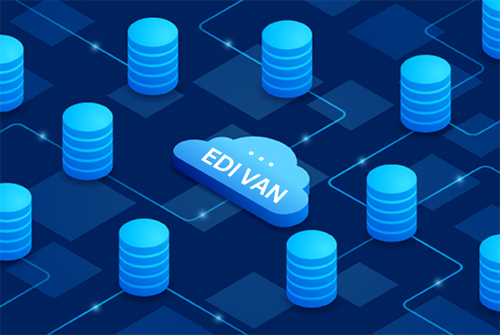
The Value Added Network, commonly known as EDI VAN, continues to be a popular method of EDI. The development of some straightforward, inexpensive options, including hybrid strategies, hasn't stopped the EDI VAN model from remaining a common choice.
If you are currently exploring the intimidating EDI implementation process, you may have heard the term VAN or Value Added Network. Below, we address the essence and definition of EDI VAN.
What Is an EDI VAN?
An EDI VAN (Value Added Network) is a private business communication network and facilitates communication between a conventional VAN and a trading partner linked to a private network or the internet. A VAN, to put it simply, functions something like a post office. It facilitates a communication route that moves data from point A to point B. Information is delivered between each partner mailbox in a VAN, and each trading partner has one. Business partners are able to send and receive EDI documents through this private data connectivity network. This middleware transfers the documents as needed.
How Is VAN Related to EDI?
While electronic data interchange is the standardized electronic format that moves data, the VAN can be considered the channel that data flows through. The VAN is the private network that delivers EDI securely from one inbox to another for a network of linked businesses.
Why Do Businesses Use VANs?
Overall, a VAN decreases the total number of involved stakeholders for a business, therefore reducing internal, business-to-business complexities. This streamlined method is meant to lower the document-by-document processing costs by way of a centralized system with real-time tracking, communication management, multiple connectivity options, local data integration, and rapid message delivery. This helps a company communicate with multiple businesses more efficiently by minimizing the number of direct connections. Ideally, this leads to more efficiency in supply chain management. Moreover, EDI VANs operate across all industries. An EDI VAN (Value Added Network) provides a business-to-business (B2B) network of electronic communications, a network that includes a variety of "value added" services as well as facilitated communication protocols that are otherwise unavailable when going through the internet or regular phone lines.
As businesses grow, setting up individual EDI integrations with each trading partner and customer they wish to communicate with becomes overwhelming. VAN providers developed advanced service offerings like EDI translation, encryption, management reporting, and secure e-mail as part of a 'value-add' package, which depends on the provider. Some VANs only provide data transfer because they assume EDI documents are correctly prepared by default. Other VANs can also manage the mapping of EDI data, therefore in addition to data transfer, they can also include data conversion.
One main value is connection and integration disentanglement. For example, onboarding new clients and setting up connections can be a complex, ongoing process. In fact, onboarding and setting up connections with new customers is one of the biggest EDI-related challenges companies experience. One survey found that 42% of integration experts claimed it took more than a month to onboard new trading partners in 2021, up from 37% in 2020.
Instead of connecting directly to each trading partner, both parties can connect to a VAN (think of it as an agent software). This "agent" handles complex integrations for the VAN customer, saving them time and effort when it comes to performing these various connections.
How Does a Value-Added Network Function?
Companies and their trading partners will connect to the same VAN, outsourced to an EDI VAN provider. Once all parties are connected, every EDI document sent between them will go through the VAN before being delivered to the intended recipient. Additionally, the VAN may translate EDI documents to their correct formats before reaching their destination.
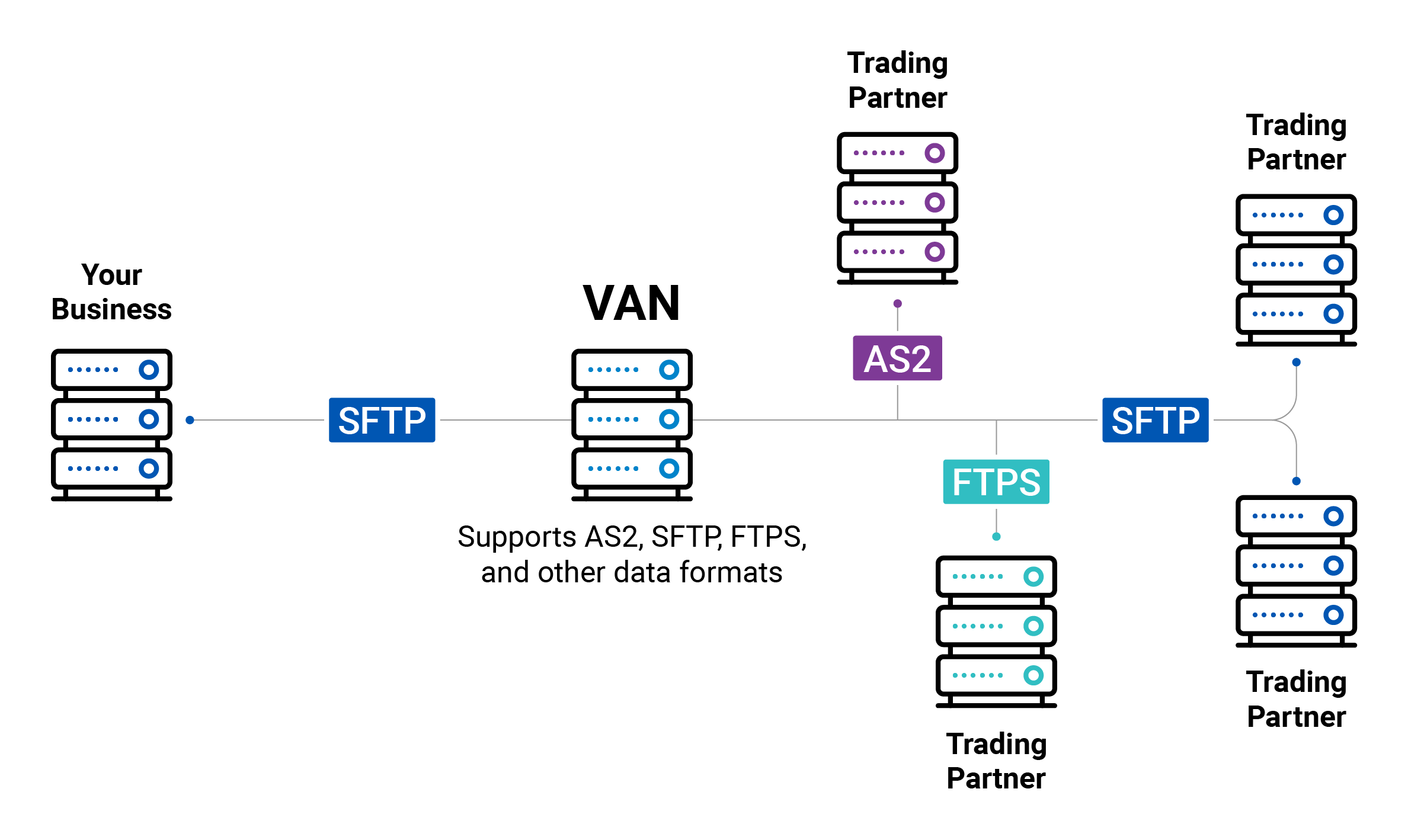
Types of Value-Added Networks (VANs)
There are different versions of VANs, most commonly including one-to-one, many-to-many, and one-to-many. Businesses select one or more of these options that best integrate with their trading partners, data requirements, transaction volumes, and industry.
One-to-One
The VAN connects only two businesses. It transports messages solely between the two parties and is usually custom-built.
Many-to-Many
Multiple companies are connected to the same VAN which allows any member in the network to share data with each other. Tends to be good for companies that connect other businesses, such as manufacturers and buyers.
One-to-Many
One company is connected to various other businesses. As an example, this option is good for a supplier that communicates with multiple retailers.
How EDI VANs Benefit Businesses
Companies that enroll in EDI VAN services typically experience the intended value, while seeing a roughly equal ratio of benefits to downfalls depending on business needs. The technology serves multiple aspects of EDI processes within supply chains and logistics, which include but are not limited to the following:
EDI Compliance and Onboarding
VANs are typically operated by third-party providers who have invested in the infrastructure necessary to ensure that messages are delivered quickly and reliably. This can be especially beneficial for organizations that do not have the resources to build and maintain their own EDI infrastructure. Companies may be able to connect with more businesses and trading partners since some VANs can translate EDI files to comply with a recipient's protocol standards. This allows for more business opportunities, thus helping companies grow.
With EDI VANs, onboarding can take a little while longer, relative to other forms of EDI systems. Companies can expect onboarding to take anywhere from a few days to more than a month. Longer onboarding times usually stem from one of three scenarios:
• A company is outsourcing onboarding responsibilities to an EDI VAN (managed service provider) who has other priorities to address that came in before the onboarding request
• A company is handling EDI VAN responsibilities internally (self-service approach) and does not have the internal bandwidth to get to the onboarding request
• The EDI VAN onboarding process is complex and cumbersome, requiring more time and resources to complete
Security
VANs often employ advanced security measures to protect the data that is being exchanged, such as encryption and digital signature verification. This can provide an additional layer of security for organizations that need to transmit sensitive information. VANS like many EDI approaches are a secure method of communication and are government and HIPPA compliant. Fundamental VAN security features typically include:
• Password Protection: users need to register and login with a username and password to access the technology
• Cryptography: EDI data and information is encrypted so only the intended recipient can interpret and understand the data
• Data Integrity: the contents of inbound and outbound messages are analyzed for errors and are flagged if an issue is found
• Nonrepudiation: electronic signatures and certificates prove that documents were sent and received by the intended parties
Integration and Connection Workload
Companies do not have to worry about having the capability to set up and maintain individual connections with each of their trading partners since all parties connect to the VAN, not directly to each other. Additionally, an EDI VAN removes the need for humans to handle communication. Both can help give team members more time to work on other pressing assignments and reduce errors and supply chain disruptions.
Quick Communication
VANs can provide a single point of connection for organizations that need to exchange EDI messages with multiple trading partners. This can make it easier for organizations to manage their EDI communications and reduce the complexity of their IT systems. EDI VANs can help speed business communication since it allows for automated responses between both parties. Humans can be removed from the process allowing quick responses, along with improved accuracy regarding a message's contents.
Connection and Data Accuracy
Pairing EDI solutions with a VAN further increases accuracy. This is because certain VANs will analyze all transactions flowing through them to identify errors. Furthermore, some EDI VANs offer the ability to automatically correct any errors to ensure transactions are accurate and retrieved by the recipient on time.
EDI VAN Transaction and Onboarding
Since VANs record all information that flows through them, businesses have a ledger of each transaction. This information is good for resolving issues with transactions or referencing information later.
How Difficult Is Implementing an EDI VAN?
While there are better or worse types of EDI deployment models based on business orientation, EDI VAN implementation from the perspective of the customer can be relatively simple, depending on the provider. However, it is not a walk in the park. Many VANs deploy partner connections manually due to legacy systems still in use or because the underlying technology is too old to support anything else. Many of these services are provided from remote locations.
Some common disadvantages of using a VAN include:
Limited control: Organizations that use a VAN will have less control over their EDI infrastructure than if they were to build and maintain their own.
Vendor dependency: Organizations are relying on third party for their EDI operations, which might add certain dependency and lack of control on EDI data.
Limited scalability: Organizations may be limited in the number of trading partners they can connect with, or in the volume of data they can exchange, by their VAN contract.
Limited integration: EDI VANs may not have the ability to fully integrate with other systems and software that the organization may be using.
Cost: VANs can be more expensive than other EDI solutions, as organizations will typically have to pay a monthly or annual fee, along with additional costs associated with workload and usage.
What Is the Value of a Value-Added Network?
VANs were popular in the 1980s because they provided security and dependability. VANs make a lot of sense for businesses that manage clients' bank account information and other financial records. Even today, VANs offer transformation, storage, and encryption services while continuing to provide the degree of dependability that businesses have grown to expect.
Is EDI VAN the Entire Solution?
EDI VANs have been around for a long time and have played a critical role in data connectivity between trading partners to execute business communications. However, with major technological advancements that have evolved the way businesses run EDI, the standard EDI solution has become more convenient, advanced, and inexpensive for many organizations who strive for control over their business.
Therefore, it is important to know that EDI VANs certainly have limitations. In many respects, relying on a VAN has become outdated, in light of the EDI technology that is and continues to become more cost-effective and modernized to better fit company systems and resources.
When thinking about implementing or switching from a VAN, there are many things to consider. In comparison to outdated VANs, data communication between vendors, partners, and customer organizations can now occur more affordably and effectively using alternative options such as an iPaaS approach. Although EDI VANs are still used by businesses, it is not always in a company's best interest to invest and base their business on the technology, and here are some big reasons why.
Service Maintenance and Availability
Service outages are common among VANs as many rely on older forms of technology. This presents itself in the form of consistent requirements for extra maintenance services. When data is not flowing as it should and there are no warnings of potential issues, businesses suffer (modern technologies are designed to alert, monitor silence, etc. to keep businesses operational).
The Black Box
EDI VANs typically do not offer strategic visibility relative to other systems. For instance, it is challenging to look for audit trails of data connectivity or to investigate specific data issues. The scenario becomes considerably worse when employing connected VAN networks. In this advanced, digital age with enormous cost-saving and connection capabilities for EDI, businesses should have complete access to the data underpinning their critical business operations. VAN users sacrifice visibility as an inherent effect of a value-added network. On another side, the issue of visibility, or lack thereof, creates a "black box," so called because you can't see through it. This means the customer is left in the dark regarding what is really happening with their company's EDI transactions. The customer waits on the provider to process their connections, updates, and communications if the provider is facing any maintenance, service challenges, or backlog.
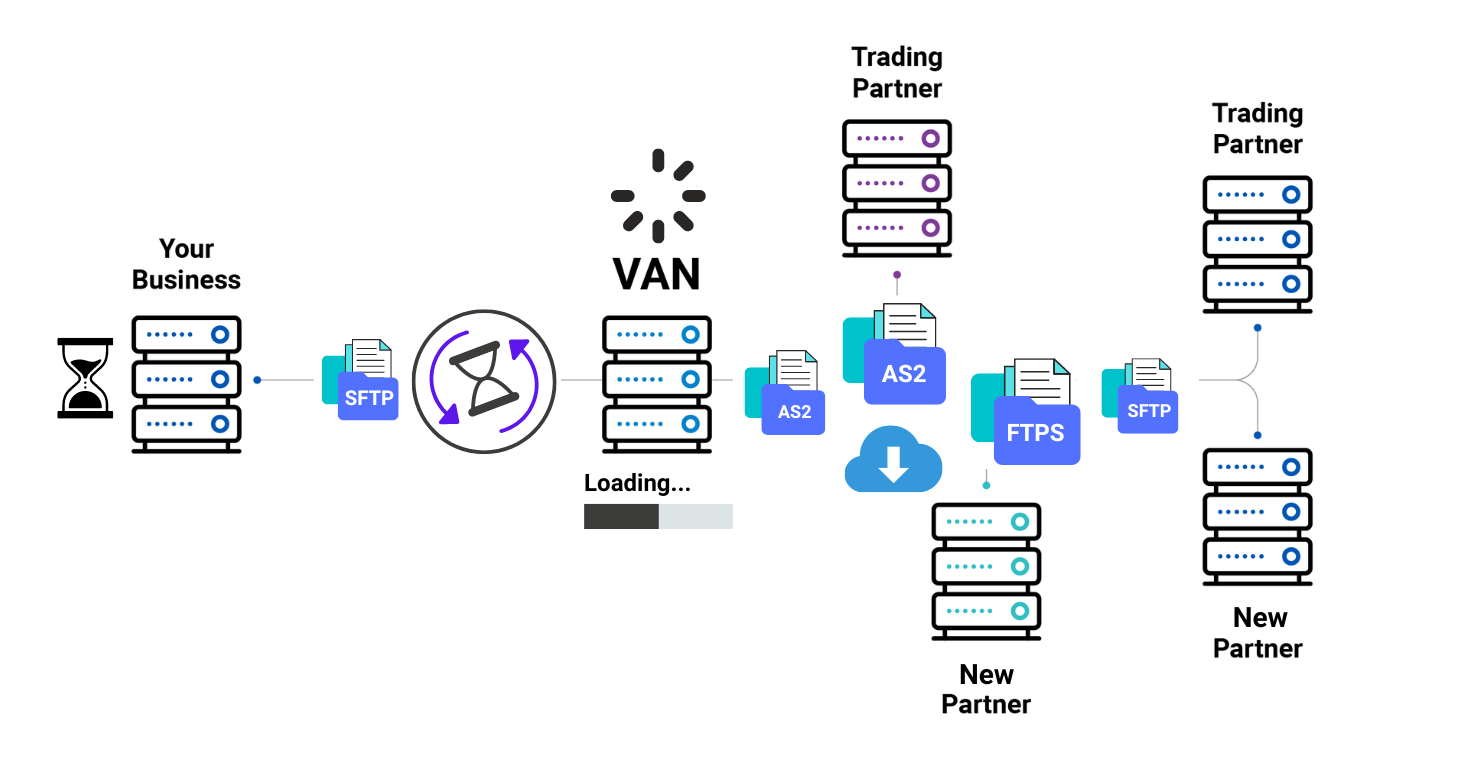
Unpredicted Service Costs
When needing to gain greater leverage on a VAN's benefits, its common you must pay monthly enrollment and installment fees in addition to per kilo-characters throughput pricing. High connection or transaction volumes typically result in surprising, excessive charges. From licensing models to subscription models, etc, service fee structures can be difficult to understand or interpret as they can be made intentionally complex.
Keeping Up with Modernization
Using a VAN limits the amount of control you would have if you employed more modern technology to manage your data. Companies want to be able to adjust and implement the right solutions. VANs, however, dictate the technology choices you have, removing your business decision for how you implement EDI. For example, one EDI advancement is the tremendous increase in interface options, allowing for better control, end-to-end connectivity, greater visibility, and improved solutions for complex integrations. Meanwhile, many EDI VANs do not have the capacity to execute in an efficient manner or even the ability to meet the integration requirements.
Companies also must consider which features they need in an EDI solution. For instance, critical EDI integration components that would support business growth for long-term expansion.
Not sure what questions to ask about EDI?
READ OUR ULTIMATE GUIDE
Which EDI System Approach Is Right for You?
When it comes to EDI implementation, there are many questions to ask prospective EDI providers, along with a few common approaches you can discuss and consider. Two of the most common approaches are as mentioned, a managed EDI VAN approach, and an iPaaS approach. There's also a third strategy, which we'll get to. But here's a look at each of them.
EDI VAN Approach
With an EDI VAN, much of everything is handled by the external party. The service provider will handle complete EDI support including implementation, deployment, maintenance, updates, error resolution, etc. The provider has its own employees that handle these tasks, so the customer has little involvement.
It's critical to identify which features are needed because every VAN provides a distinct set of features. For example, depending on the provider, VANs support different protocols — with some supporting a few common ones and others not so much, without charging additional costs or services associated with your requirements. Some providers may charge extra for supporting additional or particular protocols. Determining must-have capabilities (e.g., data security) will help narrow down VAN options.
One drawback of this approach includes limited business agility. This often looks like holding back a customer from being able to move as fast as they need to in customer transaction processing time, error-resolution, system updates, and trading partner onboarding.
Again, the issue of visibility, or lack thereof, which in many cases forces the customer to depend on the technology and timeliness of the provider to process their connections, updates, and communications. Therefore, while a managed EDI approach can be convenient, it can also be costly in terms of time, money, and true business agility.
These factors impact the entire business as it limits time-to-value for new partnership connections and updates, visibility, as well as overall business agility. This can have unintended consequences on operational flexibility, value timelines, and control.
iPaaS Approach
iPaaS means 'Integration Platform as a Service.' And 'integration platform' literally means a platform that can connect to various applications. While certain vendors have integration platforms, they're primarily meant for application to application (A2A) integration within an organization. In many cases, the EDI provider handles the creation and maintenance of the actual EDI technology. However, the day-to-day operations and optimizations to the software may be the customer's responsibility, thus requiring an in-house IT team. Think of this approach as IT teams having all the necessary pieces but still needing to put them together themselves.
On the upside, this approach almost guarantees control and visibility since an in-house team is monitoring the technology, transactions, and processes. Some iPaaS offerings include pre-built maps and customizable templates to make onboarding new trading partners quick and easy, while leveraging centralized dashboards to visualize partner connections, integrations, orders, and data.
On another hand, there's also a fully managed iPaaS approach that is similar to the managed EDI VAN method. In this approach, customers pass all iPaaS responsibilities to the managed service provider (MSP) to handle and customers can seek support from them directly as with a VAN approach . Still, customers have no choice but to wait and rely on the unseen works within the "black-box" to make changes, onboard new partners, receive updates, and gain access to certain data.
Ecosystem Integration Approach (iPaaS + B2B)
There is a third and budding approach, that simplifies much more than EDI, known as the ecosystem integration approach. Essentially, it's extending traditional iPaaS to B2B. It's a business-process-driven approach that connects and integrates the core revenue-producing business processes between a company, customers, and its business partners. A digital ecosystem can commonly be comprised of suppliers, customers, third-party data and logistics providers, and all their respective technologies, including EDI.
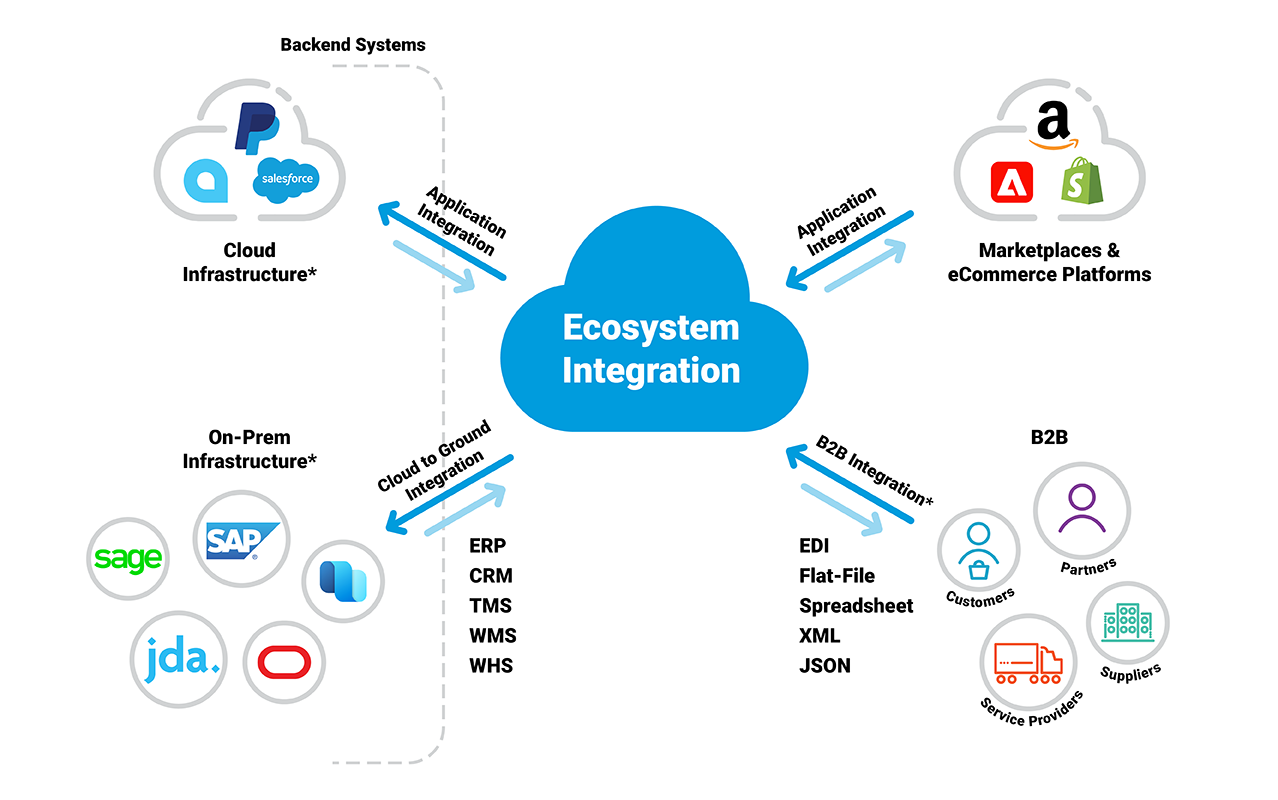
With an ecosystem integration platform, all communication, data, and information that is sent between companies will also be recorded and updated centrally in the platform, creating a single source of truth. This modernized approach allows simple connection with all necessary software like a TMS, WMS, ERP, eCommerce solution, and more. This ensures that real-time data from all integrated systems in a digital ecosystem is stored and organized, providing accurate information that can be easily accessed by any team member.
This modernization optimizes for control, tying together all the business processes and systems at play by enabling them to quickly build automated processes that possess the flexibility necessary to respond to all market disruptions. Whether its pandemics, extreme weather, and geopolitical events, as well as market opportunities such as increased eCommerce buying and fulfillment. B2B EDI gives the power to uniquely optimize businesses based on a company's given resources. Through consultation and/or guidance, companies find out which type of service option best fits their company's needs based on their internal resources, as well as current and future business goals. Options for self-service (uses an in-house IT team), fully managed (everything EDI is outsourced), or hybrid/blended approach (a personalized combination of self and fully managed services). This flexibility enables the best selection to maximize the efficiency of every EDI, API, and integration requirement for any business operation.
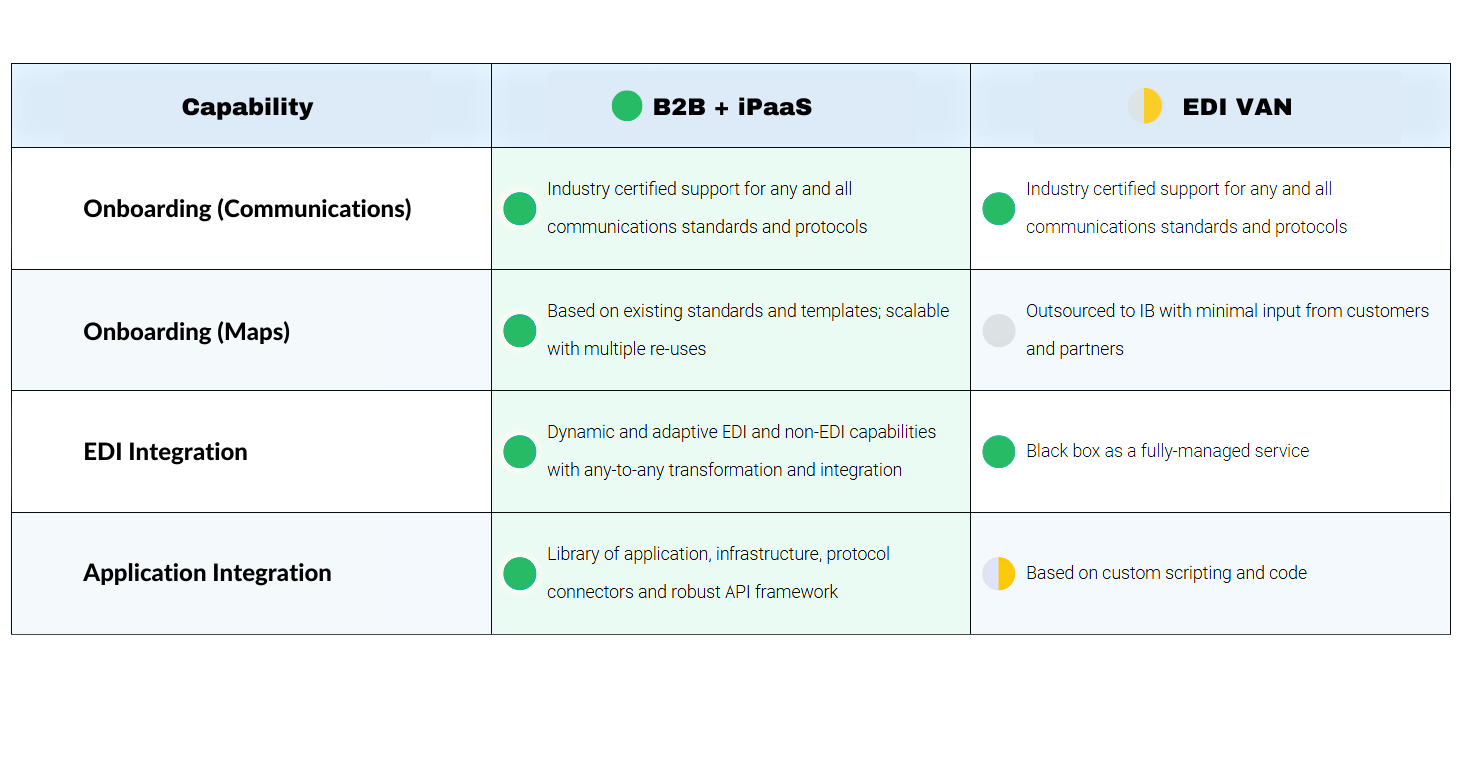
Additionally, when it comes to the actual integrations and processes, ecosystem integration provides end-to-end visibility, greater control, a single source of truth, and access to real-time data and processing (instead of batch).
Given the rise of this growing method, some of the drawbacks come out as benefits, whereas, since it's a newer approach, improvements are constantly underway. While it may be the newest of the three approaches, there are revolutionary benefits that make the ecosystem integration approach a valuable investment and something worth considering for long-term efficiency, visibility, and control.
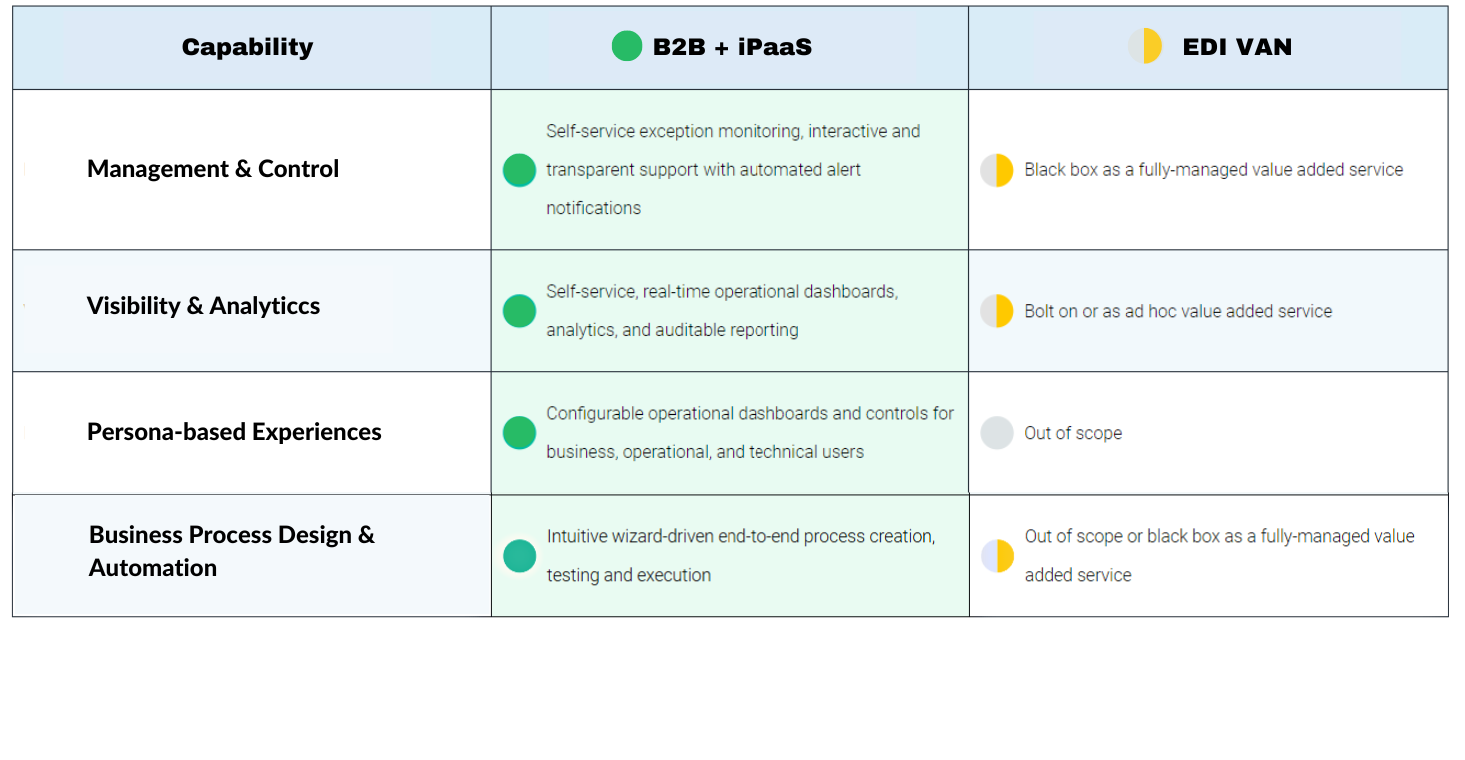
Key Takeaways
• While EDI VANs have been used by companies since the 1980s to facilitate the secure exchange of EDI documents between trading partners, they are becoming outdated as their limitations for control, agility, and visibility are becoming inconvenient for businesses to remain competitive
• Weigh the pros and cons of managed EDI VAN, iPaaS, or Ecosystem Integration (iPaaS + B2B) for which may be most optimal for your business; self-service, managed, or blended services
• When looking for an EDI solution, compare VANs and ecosystem integration solutions to see which is better for your business, as both options have their own unique benefits and drawbacks
• EDI ecosystem integration platforms are an innovative alternative to EDI VANs, as they maximize supply chain visibility, control, security, reliability, and efficiency while decreasing costs and technology complexities
• EDI ecosystem integration platforms create more direct integrations between businesses and trading partners/customers — with onboarding only taking a few hours compared to VAN onboarding which often requires weeks or months
How Cleo Can Help
Whether you're considering an EDI VAN, a managed EDI solution, or ecosystem integration, Cleo can help. For companies still using traditional EDI, instead of continuing to pay rising costs, risk outages, and forfeit control, consider more dynamic EDI and B2B integration platforms that provide a far less confusing and more controlled way of doing business. As an EDI leader in modernized B2B communications, Cleo Integration Cloud (CIC) can automate every EDI, API, and non-EDI integration, making them easy to manage and maintain while sustainably growing your business. With key features like pre-built maps, customizable templates, complete visibility dashboards, and interactive trainings, Cleo makes it easy for our customers to have everything they need to excel at business optimization.
To learn more about how businesses are gaining control through modern EDI technology, and how Cleo's cloud-based B2B integration platform can optimize your business, check out our resource library. To contact us, email us at sales@cleo.com or call us at +1.815.282.7695 to start a conversation with one of our EDI experts.

About Cleo
